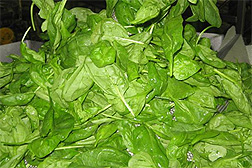This page has been archived and is being provided for reference purposes only. The page is no longer being updated, and therefore, links on the page may be invalid.
|
|
|
|
Nutrient Retention of Safer Salads Explored
By Rosalie Marion BlissMay 27, 2010
Irradiating salad leaves after washing reduces harmful and non-harmful microorganisms. Now, Agricultural Research Service (ARS) scientists and colleagues have looked into the effect of various levels of irradiation on concentrations of four vitamins and four carotenoids in two popular baby-leaf spinach cultivars.
The study was conducted by post-harvest plant physiologist Gene Lester and entomologist Guy Hallman at the ARS Crop Quality and Fruit Insects Research Unit in Weslaco, Texas. Lester is now with the ARS Food Quality Laboratory in Beltsville, Md.
For the study, two spinach cultivars were grown, harvested, sanitized and packaged according to industry practices. Each cultivar was packaged in both air or nitrogen gas as used by industry to extend shelf life. The cultivars then were exposed to up to 2.0 kiloGrays (kGy) of radiation in 0.5 kGy increments. The U.S. Food and Drug Administration has approved up to 4 kGy of irradiation for fresh iceberg lettuce and spinach.
Following irradiation, leaf tissues were tested for concentrations of vitamins C, E, K and folate (sometimes called vitamin B9) and the four carotenoids lutein/zeaxanthin, neoxanthin, violoxanthin and beta-carotene. Lester and colleagues found generally that four nutrients—folate, E, K and neoxanthin—exhibited little or no change in concentration with increasing levels of irradiation.
Levels of lutein/zeaxanthin, and B-carotene—which make up 80 percent of all carotenoids in spinach—were reduced on average by 12 percent at the 2.0 kGy level, which is within the range of natural variation.
In addition, irradiation decreased ascorbic acid levels by 42 percent, mainly due to irradiation converting vitamin C to an oxidized form called dehydroascorbic acid. While the increased dehydroacsorbic acid with irradiation is an indicator of stress, the converted ascorbic acid provides the same benefits as vitamin C inside the leaf, according to the authors.
The researchers wanted to build on literature-based food safety evidence by controlling growth and other environmental variables that could affect nutrient depletion. More details on this study can be found in the Journal of Agricultural and Food Chemistry.
ARS is the principal intramural scientific research agency of the U.S. Department of Agriculture (USDA). The research supports the USDA priority of ensuring food safety.

